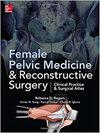Cost-effectiveness Analysis of Early Sling Loosening Versus Delayed Sling Lysis in the Management of Voiding Dysfunction After Midurethral Sling Placement
IF 1.4
4区 医学
Q3 OBSTETRICS & GYNECOLOGY
Female Pelvic Medicine and Reconstructive Surgery
Pub Date : 2022-03-01
DOI:10.1097/SPV.0000000000001165
引用次数: 1
Abstract
Objective The aim of this study was to perform a cost-effectiveness analysis comparing the management for ongoing voiding dysfunction after midurethral sling placement, including early sling loosening and delayed sling lysis. Methods A Markov model was created to compare the cost-effectiveness of early sling loosening (2 weeks) versus delayed sling lysis (6 weeks) for the management of persisting voiding dysfunction/retention after midurethral sling placement. A literature review provided rates of resolution of voiding dysfunction with conservative management, complications, recurrent stress urinary incontinence, or ongoing retention, as well as quality-adjusted life years (QALYs). Costs were based on 2020 Medicare reimbursement rates. Incremental cost-effectiveness ratios were compared using a willingness-to-pay threshold of $100,000/QALY. One-way and probabilistic sensitivity analyses were performed. Results At 1 year, early sling loosening resulted in increased costs ($3,575 vs $1,836) and higher QALYs (0.948 vs 0.925) compared with delayed sling lysis. This translated to early sling loosening being the most cost-effective strategy, with an incremental cost-effectiveness ratio of $74,382/QALY. The model was sensitive to multiple variables on our 1-way sensitivity analysis. For example, delayed sling lysis became cost-effective if the rate of voiding dysfunction resolution with conservative management was greater than or equal to 57% or recurrent stress urinary incontinence after early loosening was greater than or equal to 9.6%. At a willingness-to-pay threshold of 100,000/QALY, early sling loosening was cost-effective in 82% of microsimulations in probabilistic sensitivity analysis. Conclusions Early sling loosening represents a more cost-effective management method in resolving ongoing voiding dysfunction after sling placement. These findings may favor early clinical management in patients with voiding dysfunction after midurethral sling placement.早期吊带松动与延迟吊带松解治疗中尿道吊带放置后排尿功能障碍的成本-效果分析
目的本研究的目的是进行成本-效果分析,比较中尿道吊带放置后持续排尿功能障碍的处理,包括早期吊带松动和延迟吊带松解。方法建立马尔可夫模型,比较早期吊带松解(2周)与延迟吊带松解(6周)治疗尿道中段吊带放置后持续排尿功能障碍/潴留的成本-效果。一项文献综述提供了保守治疗、并发症、复发性压力性尿失禁或持续尿潴留的排尿功能障碍的解决率,以及质量调整生命年(QALYs)。费用基于2020年医疗保险报销率。使用10万美元/QALY的支付意愿阈值来比较增量成本效益比率。进行了单向和概率敏感性分析。结果1年后,与延迟松解相比,早期松解导致成本增加(3,575美元对1,836美元)和更高的QALYs(0.948美元对0.925美元)。这意味着早期松动吊索是最具成本效益的策略,增量成本效益比为74,382美元/QALY。在我们的单向敏感性分析中,该模型对多个变量敏感。例如,如果保守治疗的排尿功能障碍解决率大于等于57%,或者早期松动后复发性应激性尿失禁大于等于9.6%,延迟松解吊带具有成本效益。在概率敏感性分析中,在100,000/QALY的支付意愿阈值下,82%的微模拟显示,早期吊索松动具有成本效益。结论早期吊带松动是解决吊带放置后持续排尿功能障碍的更经济有效的管理方法。这些发现有助于对中尿道吊带放置后出现排尿功能障碍的患者进行早期临床处理。
本文章由计算机程序翻译,如有差异,请以英文原文为准。
求助全文
约1分钟内获得全文
求助全文
来源期刊

Female Pelvic Medicine and Reconstructive Surgery
OBSTETRICS & GYNECOLOGY-
CiteScore
2.10
自引率
12.50%
发文量
228
期刊介绍:
Female Pelvic Medicine & Reconstructive Surgery, official journal of the American Urogynecologic Society, is a peer-reviewed, multidisciplinary journal dedicated to specialists, physicians and allied health professionals concerned with prevention, diagnosis and treatment of female pelvic floor disorders. The journal publishes original clinical research, basic science research, education, scientific advances, case reports, scientific reviews, editorials and letters to the editor.
 求助内容:
求助内容: 应助结果提醒方式:
应助结果提醒方式:


